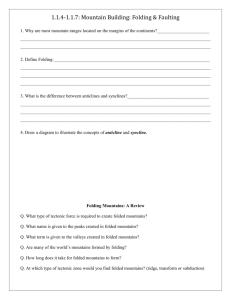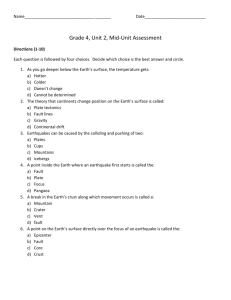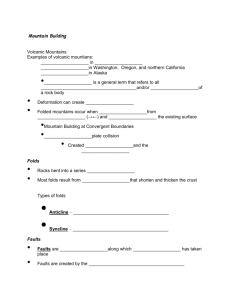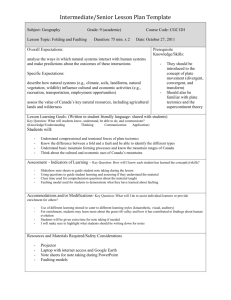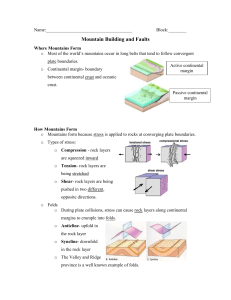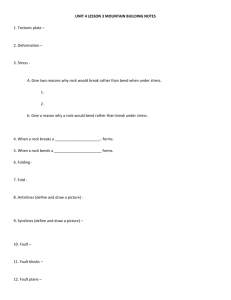Activity 1: Folded Mountains
advertisement
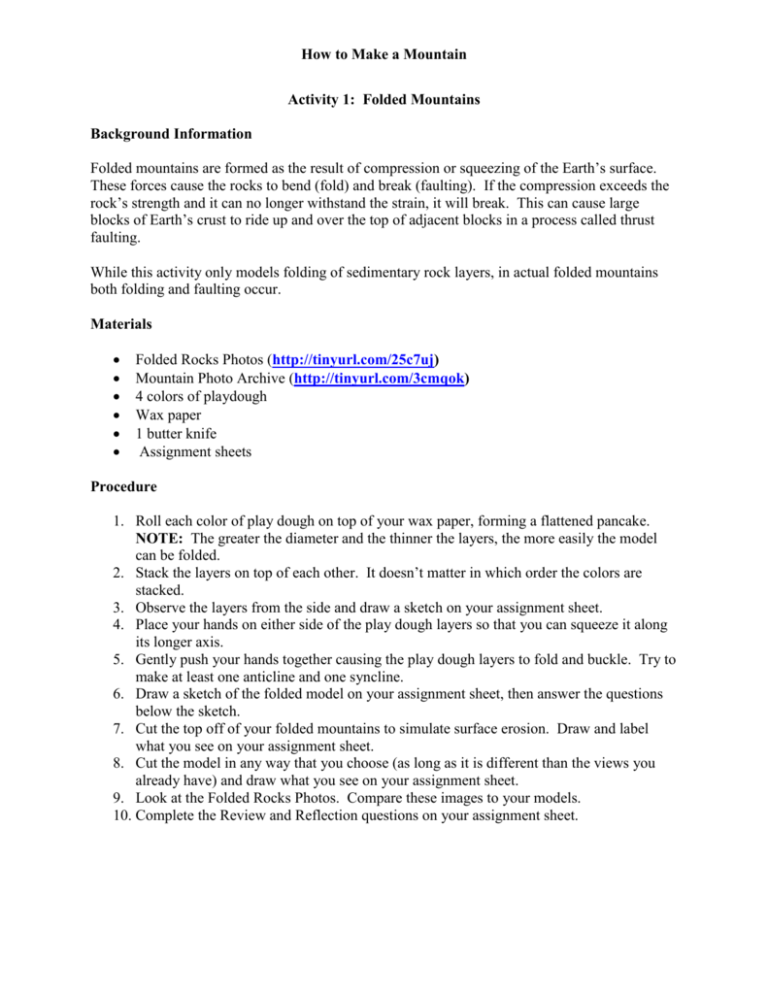
How to Make a Mountain Activity 1: Folded Mountains Background Information Folded mountains are formed as the result of compression or squeezing of the Earth’s surface. These forces cause the rocks to bend (fold) and break (faulting). If the compression exceeds the rock’s strength and it can no longer withstand the strain, it will break. This can cause large blocks of Earth’s crust to ride up and over the top of adjacent blocks in a process called thrust faulting. While this activity only models folding of sedimentary rock layers, in actual folded mountains both folding and faulting occur. Materials Folded Rocks Photos (http://tinyurl.com/25c7uj) Mountain Photo Archive (http://tinyurl.com/3cmqok) 4 colors of playdough Wax paper 1 butter knife Assignment sheets Procedure 1. Roll each color of play dough on top of your wax paper, forming a flattened pancake. NOTE: The greater the diameter and the thinner the layers, the more easily the model can be folded. 2. Stack the layers on top of each other. It doesn’t matter in which order the colors are stacked. 3. Observe the layers from the side and draw a sketch on your assignment sheet. 4. Place your hands on either side of the play dough layers so that you can squeeze it along its longer axis. 5. Gently push your hands together causing the play dough layers to fold and buckle. Try to make at least one anticline and one syncline. 6. Draw a sketch of the folded model on your assignment sheet, then answer the questions below the sketch. 7. Cut the top off of your folded mountains to simulate surface erosion. Draw and label what you see on your assignment sheet. 8. Cut the model in any way that you choose (as long as it is different than the views you already have) and draw what you see on your assignment sheet. 9. Look at the Folded Rocks Photos. Compare these images to your models. 10. Complete the Review and Reflection questions on your assignment sheet. How to Make a Mountain Unfolded Layers (side view) Folded Layers—showing anticlines and synclines (side view) What might cause similar compression to occur to the Earth’s crust? Give an example of where this might occur. Top cut off to model surface erosion: How to Make a Mountain Student Choice: Compare the images you see in the Folded Rocks Photos with your models. Review and Reflection 1. How does the model you make illustrate processes at work in the Earth’s crust? 2. What is the name of the force at work in the Earth’s crust that makes folded mountains? 3. Look at the Mountain Photo Archive. Which, if any, of these mountains look like they are made of folded layers? How to Make a Mountain Activity 2: Fault Block Mountains Background Information Fault-block mountains are formed by the sinking or rising of huge blocks of the earth’s surface relative to the neighboring blocks. The Basin and Range region of Nevada, Arizona, New Mexico, and Utah is one of the most extensive regions of fault block mountains. This activity demonstrates how faulting can create mountains. Materials Mountains Formed by Faults photos (http://tinyurl.com/34ydj3) 5 or 6 hardback books approximately the same size ruler Fault block paper models Assignment sheets Procedure 1. Hold 5 or 6 hardback books upright on a desk (binding vertical). These books represent Earth’s crust and the spaces between them represent faults in the crust. The letters of the title represent sedimentary layers. 2. Place a ruler across the top of the books and measure the width beginning with the first book on the left and ending with the last book on the right. 3. Draw a sketch of the Fault Block Mountains on your assignment sheet. 4. Move one hand so that the books tilt to one side at a 30-45 degree angle (estimate this). 5. Measure the horizontal width using the same technique as above. 6. This models the stretching of the crust—tension. Draw a sketch of the model on your assignment sheet. Be sure to label the mountains and the valleys 7. Answer the Review and Reflection questions. How to Make a Mountain Model before stretching of crust Crust Width ________ Model after stretching of crust Crust Width _______ Review and Reflection 1. What force causes crust stretching to take place? 2. What changes occurred in the crust as the surface stretched? 3. Look at your before and after drawings. How did the measurements change? Why do you think this happened? 4. Look at the picture of the Basin and Range Province in Nevada (Mountains Formed by Faults photos). Based on what you have just learned, how do you think these mountains were formed? How to Make a Mountain Activity 3: Paper Model Faults Background Information Faults are cracks in the crust where sliding occurs. We classify faults based on the direction of relative motion into normal faults, reverse faults, and strike-slip faults. These paper models of faults show how that relative motion occurs. Materials Paper models of the normal fault, strike slip fault, reverse fault, horst, and graben. (http://tinyurl.com/2p9e9g) colored pencils Assignment Sheets Procedure 1. Move from one model station to another, drawing sketches of each of the fault types exhibited. For each sketch, be sure to label the hanging wall (A), foot wall (B), and use arrows to show the relative motion of each side of the fault. Use the line beneath the box to label the type of fault. 2. Answer the Review and Reflection questions on your assignment sheet. How to Make a Mountain Type of Fault: _______________________________________________________________ Type of Fault: _______________________________________________________________ Type of Fault: _______________________________________________________________ How to Make a Mountain Type of Fault: _______________________________________________________________ Type of Fault: _______________________________________________________________ Review and Reflection 1. Which types of faults are produced by tension, compression, and shear? Tension: ________________________________________________________________ Compression: ___________________________________________________________ Shear: _________________________________________________________________ 2. In looking at the paper fault models, which types of faults do you think could contribute to mountain building? Why? 3. Look at the Mountain Photo Archive (http://tinyurl.com/3cmqok). Which, if any, of these mountains look like they could have some faulting associated with them?
